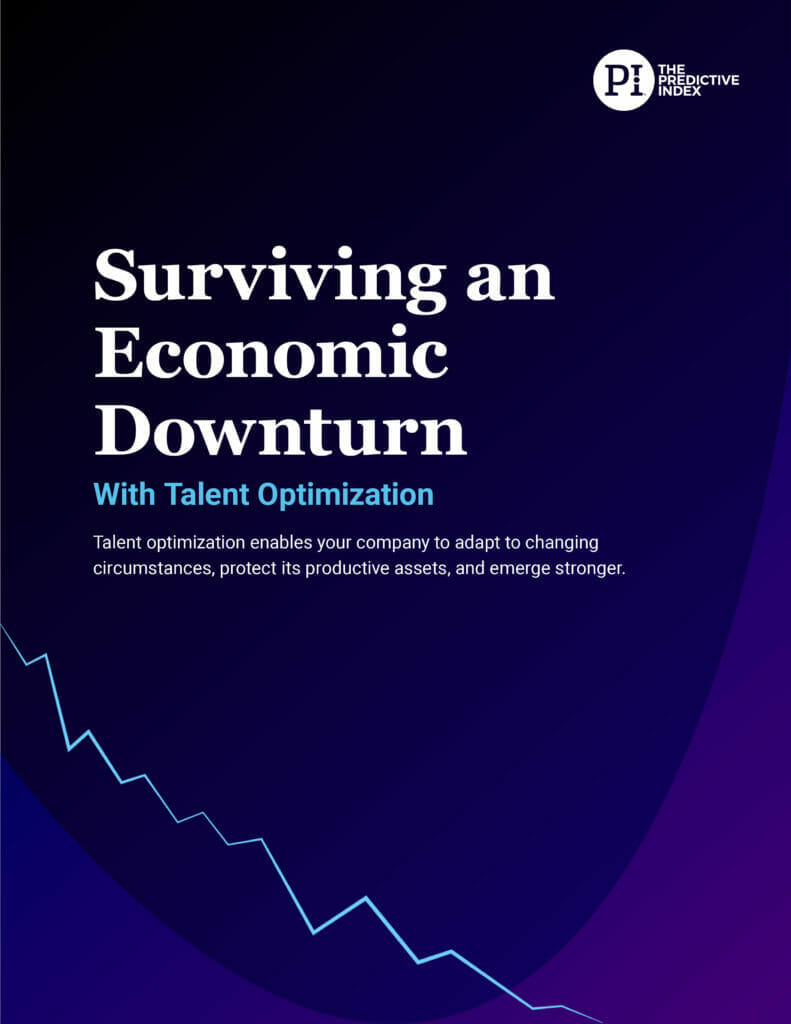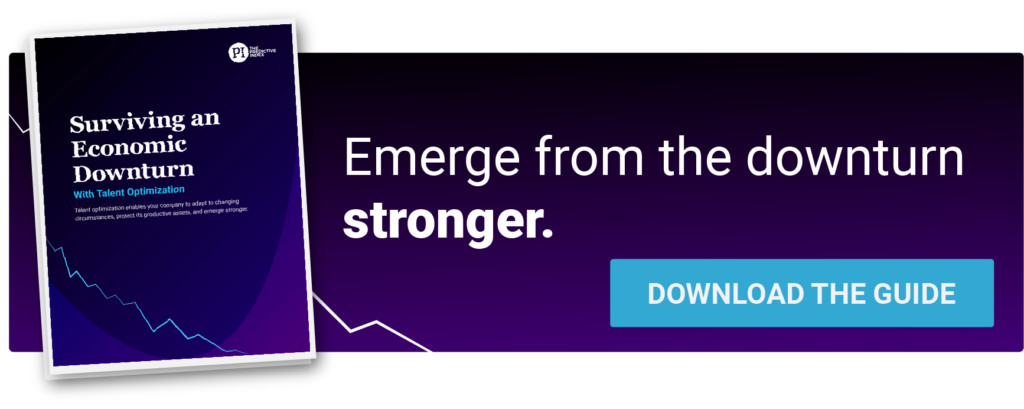
Surviving an Economic Downturn
with talent optimization
Talent optimization enables your company to adapt to changing circumstances, protect its productive assets, and emerge stronger.
Let the storms show your mastery.
As a business leader, we know you care deeply about building a lasting company. With COVID-19 and the resulting economic downturn, major uncertainty lurks in the dark clouds rolling in overhead:
- When will the virus be contained?
- Can we make key business decisions quickly?
- How do we preserve our culture?
- How can we avoid going out of business during any lockdown?

You’re navigating uncharted waters, battered by turbulence and propelled forward by an urgent, deep-seated need to lead your company to safety—so it can endure.
Business is a team sport. Seeing your employees succeed is important to you. You have a duty of care; their overall well-being matters. Whereas the 2008 recession was more of an economic issue, our current reality is that we first have to get through a health crisis and then deal with its socioeconomic wake. There are so many unknowns.
We trust you’ve taken every step to protect the physical health and well-being of your employees and their families based on World Health Organization and Centers for Disease Control and Prevention guidance. Aside from taking health precautions, the best way to take care of your people is to ensure your company is resilient. And that’s what this guide will help you to do.
Your survival hinges on agility.
While recessions impact most organizations, an HBR study found 9% of companies flourished after a slowdown. What did these companies’ senior teams do differently that you can learn from? They ensured agility and resiliency. In a speech, professor Leon Megginson summarized Darwinism: “It is not the most intellectual of the species that survives, it is not the strongest that survives, but the species that survives is the one that is able best to adapt and adjust to the changing environment in which it finds itself.”
In a crisis, your company’s survival hinges on your ability to mobilize and inspire your talent. Your decisions and actions determine whether your people will be an asset or a liability. Ideally, your talent ensures adaptation by quickly developing and implementing a new operating model. But a variety of talent missteps can cause business failure:
- Employees aren’t aligned with the new strategy
- Leaders are oblivious to employee struggles
- Leaders poorly manage the impact of a reduction in force
- Hiring teams don’t reevaluate job requirements and needed skills
Rapidly pivot as needed.
Talent optimization is a discipline for designing and executing a talent strategy that’s aligned with your business strategy. It utilizes quantitative “people data” and analytics to help you predict outcomes and make informed decisions. While it’s hard to manage panic and the impulse to make knee-jerk decisions, objectivity will be your saving grace.
As mentioned in the 2020 State of Talent Optimization Report, you can maximize strategic performance by crafting an aligned talent strategy that empowers your employees to handle the execution themselves. The study found specific combinations of talent optimization practices translated to positive business results. For example, senior leaders at companies that practice talent optimization reported that 89% of their strategic initiatives were successful—that’s 22% higher than average (73%). Especially now when you need to grab every advantage you can, improving outcomes by 22% is an enormous market differentiator.
Talent optimization enables your company to rapidly pivot in light of changing circumstances—so you can make tough decisions, fast and with confidence. While talent optimization is a solution for everyday business challenges, it’s exceptionally helpful in times of change and uncertainty. It’s a practical way to ensure agility and resilience.
Solve your top challenges.
In this guide, we use the four aptitudes of talent optimization—Design, Inspire, Diagnose, and Hire—to provide a framework for how to adapt your business and solve the following challenges:
Reduction in demand: COVID-19 caused a sudden and massive slowdown in economic activity and a drastic reduction in demand for products and services. Customers may pay late, pause contracts, cancel, and freeze discretionary spending. Deals in the sales pipeline may not close.
Reduction in spending: The reduction in demand means companies must adjust their cost base and investments accordingly. Conserving cash, temporarily rightsizing capacity, or permanently reducing headcount is necessary to preserve the core and keep operations running.
Supply and infrastructure disruption: Supply chains may break down, and inventory may be depleted. Meetings, travel, and events have already been canceled for the most part. School and daycare cancelations will cause additional business interruptions. While these are necessary to reduce community spread of the virus, they mean more stress for working parents and they threaten your organization’s ability to continue operating efficiently, if at all.
Remote work: Remote work is a radical disruption to many organizations. Even if you had flexible work arrangements in place before the pandemic, shifting to a 100% remote workplace brings both logistical and interpersonal challenges that interfere with the job to be done.
Uncertainty and fear: No one knows for sure when the virus will be contained. No one knows how severe economic conditions will become, or how long they’ll last. Uncertainty and fear can prevent employees from speaking up to share new ideas or innovate— exactly what organizations need during hard economic times. Fear can also drive down engagement levels and receptiveness to change.
Take swift action and face difficult situations.
These are just a few of the many challenges you’re facing right now. You’ll need to take swift, difficult action to rise above them. You’ll need to have a solid action plan.
- How will you lead very different operations once your strategy has changed?
- How will you preserve your culture when employees are dispersed and stressed?
- How will you restore communication and collaboration in teams that have lost key members—or leaders?
- How do you help your mid-level managers not buck under the pressure of doing more with less?
Talent optimization is the key to ensuring:
- Rapidly realigned strategy and capabilities (Design)
- Adaptable operating model and culture (Diagnose)
- Resilient leaders, teams, and individuals (Inspire)
- Realigned jobs to accomplish more with less (Hire)
More importantly, talent optimization enables you to adapt to change and lead through turbulent times—so your business can come out on top. Let the storm show your mastery.
Download guide
Within each section, you’ll find checkboxes. As you apply your new insights within your company, use the checkboxes to stay on track.
Get the slides
Don’t have time to read a 33-page guide? This slide deck highlights key takeaways. It’s ideal for sharing with other business leaders.
Download checklist
For a complete look at all 21 action steps you could take to ensure an agile, resilient company, download this checklist.
